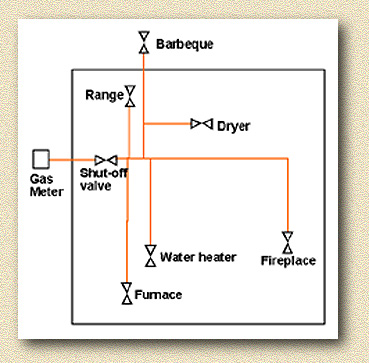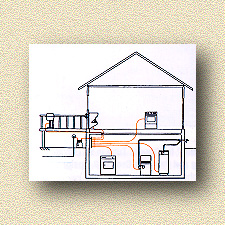February 2004
Flexible copper gas tubing - the flexible approach for supplying today's homes with clean, comfortable natural gas. Copper tubing creates convenience, safety, and ease of installation for builders and homeowners alike. For decades, the excellent performance of copper tube has been demonstrated in many applications: water supply and drainage; medical gas; heating, ventilating and air conditioning (HVAC), and fire sprinkler systems. Now flexible, convenient, copper tubing is demonstrating its value again, in supplying clean, comfortable natural gas and liquefied petroleum (LP) gas - today's fuels of choice for residences.
Advantages of Flexible Copper Tubing
Copper tubing gives all these advantages, as compared to traditional black iron pipe:
- Copper tube's flexibility allows sharper bends and easier installation, particularly in confined spaces.
- Flexible copper tubing can be snaked and routed easily through typical wall and ceiling construction. This makes it easier and more economical to bring all the advantages of modern natural gas service to more locations throughout new and renovated residences. For example, safe, convenient gas fireplaces can easily be located in upstairs bedrooms, or a quick-connect outlet installed outdoors on the deck for a gas barbecue grill.
- Easy joining means a faster, less expensive installation as compared to traditional black iron pipe.
- Long lengths (up to 100 feet standard) make it possible to eliminate joints in walls, floors and ceilings. This improves safety by minimizing the potential for leaks.
Low Cost, High Convenience
Installing interior fuel gas systems using flexible, durable copper tubing is quick and easy compared with traditional systems based on threaded iron pipe. For new one- and two-family dwellings, copper gas systems are often the least expensive solution. For present gas consumers, copper tube offers maximum ease of retrofit installation for adding new gas equipment and appliances (such as a quick-connect outlet for an outdoor gas barbecue, or a gas fireplace in the master bedroom) after original construction. The bottom line? Increased convenience for using clean, comfortable, gas for heating and cooking in both new and existing residences.
High and Low Pressure
Copper tubing can be used to supply both low pressure natural gas systems (those operating at less than 0.5 pounds-per-square-inch-gauge) and elevated pressure systems up to 5 psig. Currently, 2 psig systems are the most common elevated pressure systems used for residential installations. Since elevated pressure means smaller pipe diameters, gas supply systems operating at 2 psig and higher are a perfect application for flexible copper gas tubing.
Residential Copper Gas Systems
There are two main types of natural gas piping layouts. The "traditional" design uses a main run with lines branching off to supply gas to individual appliances ( Figure 1). This is most often used with old-style black iron pipe.
 Figure 1. Gas System with Branch Runs.
Figure 1. Gas System with Branch Runs.Flexible copper gas tubing, on the other hand, is particularly well suited to a newer distribution design that uses individual runs of copper tube, sometimes called "home runs," to each appliance from a gas distribution manifold ( Figure 2). This type of design makes it easier to service individual gas appliances, or add new ones, without disturbing the rest of the home gas system.
 Figure 2. Gas Manifold System with Individual Runs
Figure 2. Gas Manifold System with Individual RunsSafety Standards
Flexible copper tubing has been used successfully with natural gas systems for over 30 years in the United States and Canada. Its use is permitted by safety standards and building codes in both countries. For additional information about interior fuel gas systems, visit our Fuel Gas section.
